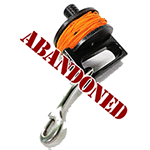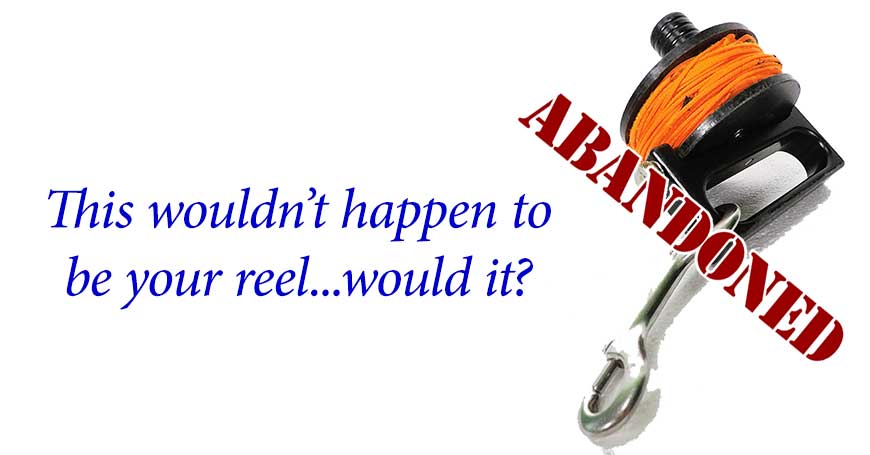 If you cave dive, it’s almost inevitable that one day, for any of a variety of reasons, you may be forced to leave a reel in the cave that you hadn’t intended to. It’s usually because you were not able to make a subsequent dive during which you planned to retrieve a primary or jump reel you installed on a previous dive. This could be because a team member wasn’t feeling up to it physically, or perhaps an equipment malfunction prevented you from diving. Whatever the reason, it’s important that you not simply leave the reel without telling anyone and have a plan for its removal.
If you cave dive, it’s almost inevitable that one day, for any of a variety of reasons, you may be forced to leave a reel in the cave that you hadn’t intended to. It’s usually because you were not able to make a subsequent dive during which you planned to retrieve a primary or jump reel you installed on a previous dive. This could be because a team member wasn’t feeling up to it physically, or perhaps an equipment malfunction prevented you from diving. Whatever the reason, it’s important that you not simply leave the reel without telling anyone and have a plan for its removal.
(Note: This article deals chiefly with north-central Florida caves; however, many of the principles apply everywhere.)
Abandoned reels cause very “reel” problems
So why is leaving a primary or jump reel in place for any more than a day or two a problem? For several reasons, actually.
- It makes it harder for other teams to run reels. It’s tough enough to lay a guideline properly when yours is the only one in the cave. However, with each additional guideline you need to work around, doing so becomes even harder still. Eventually, it becomes nearly impossible to do so without posing a risk of entanglement to others.
- It can pose a risk to others all by itself. Even the best placed guidelines don’t tend to stay that way. Over time, tie offs and placements tend to come undone and line gets loose. Thus, a once well placed guideline can become a menace to passing traffic.
- It causes damage to the environment. Every time a guideline comes in contact with soft limestone, damage occurs. This damage may be imperceptible but, over time, it adds up. For example, the bottom of Devil’s Ear once had loads of good tie off points. Over time, though, they have almost all been worn away. Forcing others to run guidelines in places where they would not normally just adds to the damage.
- Unattended reels can serve as an enticement for unqualified divers to enter the cave. This is especially true if your primary tie off was made in open water instead of just inside the entrance. Despite having made significant progress in reducing the number of open-water diver fatalities in caves over the past 25 years, we still find recreational divers venturing into the overhead without proper training and equipment. Now we have a new concern: Freedivers. Although properly trained freedivers understand the importance of not entering overhead environments, most of the would-be breath-hold divers we see lack this training. To them, an unattended reel can serve as both an enticement and provide a false sense of security.

Whether a primary or jump reel, yours should remain in the cave only long enough to ensure youe own safety…and then you should get it the Hell out before it causes problems for others.
So when is it okay to intentionally leave a reel behind?
There are, of course, times when it is perfectly okay to leave a reel in a cave. Examples include:
- You are making back-to-back dives. If you are making two dives at the same location, on the same day, it makes sense to put a primary reel in at the start of the first dive and pull it at the end of the day.
- You are setting up for a circuit or traverse. Dives involving complex navigation only work if you leave one or more reels in place, to be pulled as you complete the circuit or traverse. That having been said, you have to ask, “Is it really necessary to do this kind of dive?” Complex circuits and traverses entail additional risk and are generally not the most efficient way to explore caves. Equally important, they require you to leave jump reels behind, which may inconvenience others. You should, ideally, be completing any circuit or traverse you have set up on the same day. Leaving reels in place in anticipation of returning for them the next week or month is just plain inconsiderate.
- When specifically asked to do so by the landowner. It used to be a standard of practice at Ginnie, during times when rising river water limited access to the cave to Devil’s Eye, for management to ask someone to install a semi-permanent guideline from the cave entrance to the start of the gold line (this was before the gold line was moved to its present location). The primary tie off would always be labeled with a slate explaining what it was and how long it would likely be there. This was done to prevent teams from running multiple guidelines through an area where doing so would easily cause problems.
What should you do if forced to leave a reel behind?
As you’ve no doubt read by now, leaving a reel in a cave for anything longer than the shortest time possible is not a good idea. But as we said going in, what should you do if this happens unintentionally? Waiting until your next trip to cave country is not an option. Instead:
- Go back and get it if possible. Yes, this may mean going and getting a fill and making a second, or even a third dive of the day. But if it was you who left the reel in place, it should rightfully be you who fixes the problem, if you can do so safely.

- Have a plan to ensure that someone removes your abandoned reel as soon as possible. It’s unusual to be at a dive site all by yourself. Ask the next team going in if they can pull the reel for you and, if they will not be going that way, try to find a team that is. Needless to say, as this will be easier than going back for the reel yourself, you may owe somebody a gas fill, lunch or drinks.
- Tell someone. If you can’t get the reel yourself or have another team retrieve it for you, don’t simply leave the scene without telling someone else what happened. That someone should be park management at a state park or Ginnie. Otherwise, notify someone at the closest local dive center. Whatever you do, don’t leave the rest of us guessing whether or not you made it out alive.
Running a reel is more than just a skill; it’s a responsibility. Start diving like an adult and put your toys away when you are done with them.
